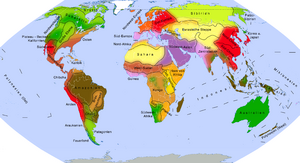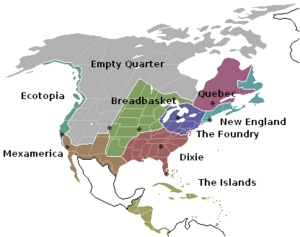Cultural area facts for kids


In subjects like anthropology (the study of human societies) and geography (the study of Earth's features), a cultural area is a region where people share similar ways of life. This means they often have similar traditions, languages, and activities. These shared activities are usually connected to a specific group of people who speak the same language or have a common background. A cultural area doesn't always follow the exact borders of a country or state.
Contents
How We Got the Idea of Cultural Areas
Early Ideas and Development
The idea of cultural areas began in the late 1800s. Museum curators and ethnologists (people who study cultures) used it to organize their exhibits. They wanted to group similar items and traditions together.
Later, two researchers named Clark Wissler and Alfred Kroeber helped develop this idea further. They believed that cultural areas showed long-lasting ways that cultures were divided.
Debates About Cultural Areas
Some people disagree with the idea of cultural areas. They argue that the way cultures are grouped can be chosen unfairly. However, many other researchers believe that organizing human communities into cultural areas is still very useful. It helps us understand how different groups of people live and interact.
Today, cultural areas are becoming even more important. This is because social scientists are studying how cultures are becoming more connected around the world due to globalization.
Different Kinds of Cultural Regions
Understanding Cultural Cores and Spheres
Researchers have used different terms to describe parts of cultural regions. A "cultural hearth" is like the starting point or origin of a culture. A "cultural core" is the main, strongest part of a cultural area. For example, Donald W. Meinig used this term for the center of Mormon culture.
Outside the core, there's a "domain," which is a wider area where that culture is still very strong. Beyond that is a "sphere," which is an area influenced by the culture but where it might not be the main way of life.
Overlapping Cultures
Cultural "spheres of influence" can sometimes overlap. This means one area might be influenced by more than one culture. Also, large cultures (macrocultures) can include smaller, local cultures within them. The way we define these areas can change depending on what we are looking at. For example, the boundaries might be different if we study religion compared to language or clothing styles.
Cultural Boundaries
What is a Cultural Boundary?
A cultural boundary is a geographic line that separates two different cultures or groups of people. A language border is always a cultural border, because language is a big part of a society's culture. But cultural boundaries can also divide smaller groups within the same language family. This might happen due to subtle differences in traditions or customs.
Historical Examples in Europe
In the history of Europe, some important cultural boundaries include:
- In Western Europe, a boundary existed between Latin Europe (where the influence of the Roman Empire was strong) and Germanic Europe (where Roman culture mixed with Germanic traditions).
- In the Balkans, the Jireček Line separated areas mainly influenced by Latin (from the Western Roman Empire) from those mainly influenced by Greek (from the Eastern Roman Empire).
Large-Scale Cultural Areas
Very large cultural areas, covering whole continents, are sometimes called "worlds," "spheres," or "civilizations." An example is the Muslim world.
Modern Cultural Divisions
In modern times, a cultural boundary can also be a division between different groups or classes within a single society. For instance, the difference between "blue collar" (manual labor) and "white collar" (office work) jobs can create cultural boundaries.
Special Terms: Cultural Bloc
Understanding Cultural Blocs
The term cultural bloc is used by anthropologists to describe groups of Aboriginal peoples of Australia who are similar in their culture and language. For example, the Western Desert cultural bloc includes many groups in central Australia who speak about 40 similar dialects. Other examples include the Noongar people in southwestern Australia and the Yolngu cultural bloc in Arnhem Land.
Examples of Cultural Areas Around the World
Big Cultural Divisions
- East–West dichotomy: This is the idea of dividing the world into Western civilization (like Europe and North America) and the Eastern world (like Asia).
- Global North and Global South: This division broadly refers to differences in wealth and development between countries, with the "North" being generally richer and the "South" being generally poorer.
Geographic Cultural Areas
* East Africa * North Africa (including the Maghreb) * Southern Africa * West Africa
* Caribbean * Central America * Mesoamerica * North America * South America
* Far East * Middle East * Near East
- Indian subcontinent
- Pacific islands:
* Melanesia * Micronesia * Polynesia
* Mainland Southeast Asia (Indochina) * Maritime Southeast Asia
Cultural Areas Based on Language Families
- Arab world: Countries where Arabic is spoken.
- Celtic Europe: Areas where Celtic languages are spoken.
- English-speaking world (Anglophone): Countries where English is the main language.
- Francophonie: Countries where French is widely spoken.
- German-speaking Europe
- Hispanic America: Countries in the Americas where Spanish is spoken.
- Lusophone: Countries where Portuguese is spoken.
- Latin Europe: Countries where Romance languages (like French, Spanish, Italian) are spoken.
- Sinophone: Areas where Chinese languages are spoken.
- Slavic Europe: Countries where Slavic languages are spoken.
Other Cultural Groupings
- Anglosphere: English-speaking countries with similar cultural and historical ties.
- East Asian cultural sphere (Sinosphere): Areas historically influenced by Chinese culture.
- Nordic countries: Countries in Northern Europe (like Denmark, Sweden, Norway) that share cultural ties.
- Russian world: Areas influenced by Russian culture.
Cultural Areas Based on Religious Beliefs
- Christendom (Christian world): Areas where Christianity is the main religion.
- Muslim world: Areas where Islam is the main religion.
Music Areas
A music area is a cultural area defined by the type of music people create and listen to. These areas might not always match other cultural areas. The world can be divided into three large music areas:
- Europe and Sub-Saharan Africa
* They often use similar musical scales and create music with multiple parts (polyphony) that sound good together.
- North Africa, Southwest Asia, Central Asia, South Asia, Indonesia and parts of Southern Europe
* Their music often uses smaller steps between notes in their scales and melodies.
- American Indian, East Asia, Horn of Africa, Northern Siberian, and Finno-Ugric music
* These areas often use scales with five notes (pentatonic scales) or four notes (tetratonic scales), with larger jumps between notes.
See also
 In Spanish: Área cultural para niños
In Spanish: Área cultural para niños
- Continent
- Cultural geography
- Culture
- World language











